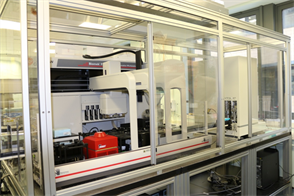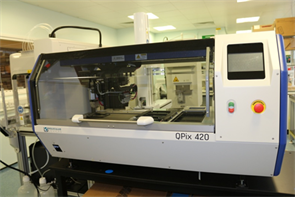SBRC Robots
Robotics
The SBRC-Nottingham robotic suite is a custom-made system consisting of two interconnected robotic platforms including:
- Two Biomek FXp dual arm liquid handling instruments with multichannel 96-head and Span-8
- 2D and 1D barcode readers
- Pin Tool for microbial colony transfer
- Integrated T-Robot thermal-cycler, shaking platform and peltier devices
- SCARA robotic arm and robotic shuttles that link all integrated devices
- Molecular Devices Q-Pix 420 HT for high throughput colony picking up to 2000 colonies per hour plus bacterial spreading applications on omnitrays and QTrays
- Solid Phase Extraction (SPE) system and magnetic based DNA purification system
- Integrated Cytomat 2 tower shaker incubators and Cytomat plate hotels
- BigNeat enclose to ensure sterile air flow over workspace
- Molecular Devices SpectraMax i3 multi-mode plate reader
- High-throughput electroporation system (BTX™ Gemini X2 HT Electroporation System)
- High-throughput gel electrophoresis system
The instruments within both platforms can work in standalone and integrated modes.
Our robotic system allows for the setup of customized protocols and workflows. It gives a wide range of options for gene assembly, microbial transformation (chemical and HT electroporation), colony plating and picking, transformant library screening, purification of nucleic acid, proteins and analytes, size selection of DNA bands, high throughput electrophoresis and efficient sample tracking.

Gene assembly, PCR, DNA size selection, microbial transformation, cherry picking and quality control.

Colony picking, culture plating, inoculation and sample collection.
A video of the SBRC robot in action within The Biodiscovery Institute
Examples of uses:
- Compound library screening;
- Automated 96 well plasmid DNA preparations (Promega Wizard® MagneSil® Plasmid DNA Purification System);
- Automation of qRT-PCR reaction plate set-up;
- TRADIS and NGS library construction;
- Biosensor development;
- Inducible system development (https://www.nature.com/articles/s41467-020-14941-6#Tab1).